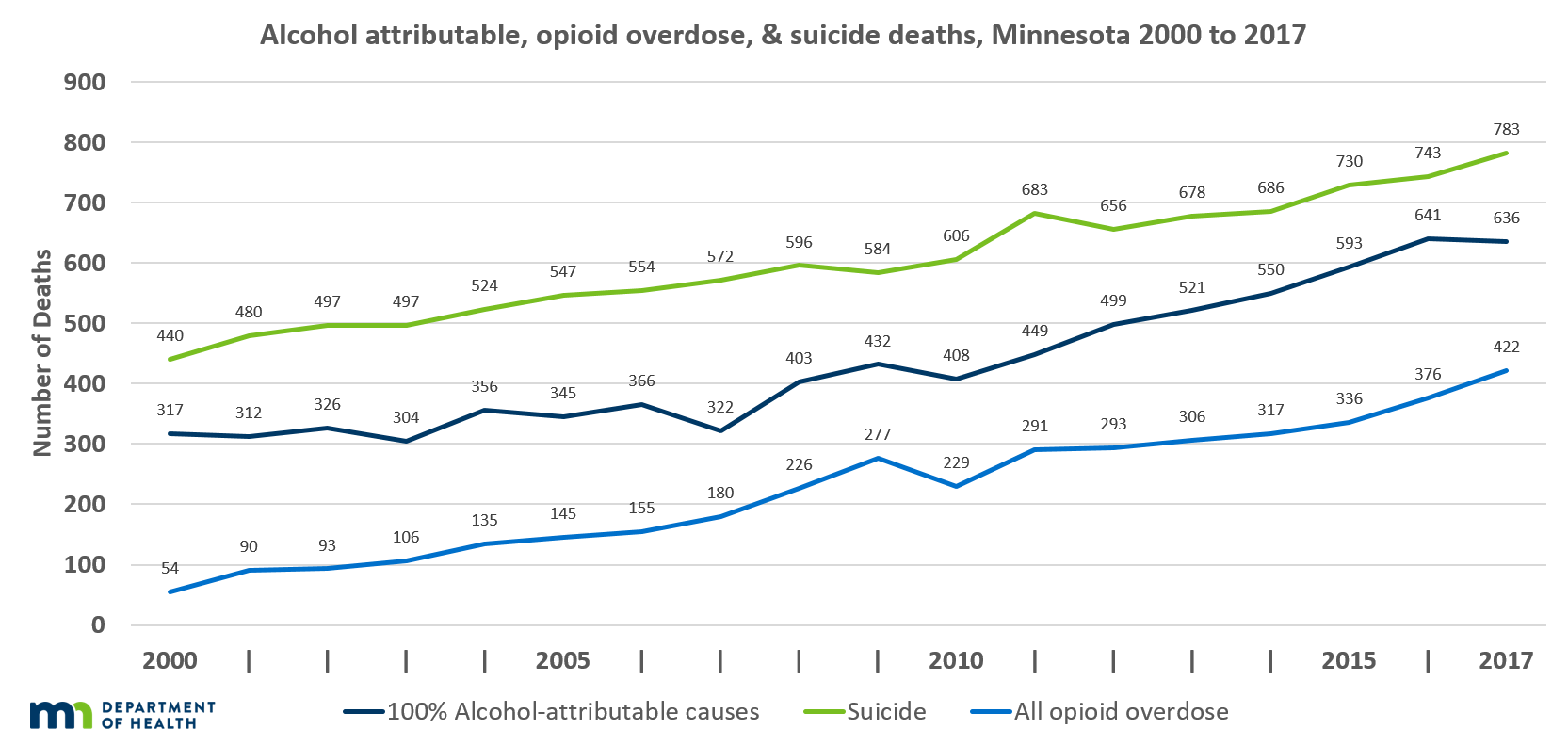News Release: 2017 data show deaths continue to rise from opioids, alcohol and suicides in Minnesota
Minnesota Department of Health sent this bulletin at 03/18/2019 09:05 AM CDT
2017 data show deaths continue to rise from opioids, alcohol and suicides in Minnesota
More Minnesotans died from opioids, alcohol and suicide in 2017 compared to previous years, continuing a worrisome long-term trend for individuals, families and entire communities.
In 2017, 422 Minnesotans died from opioids, 636 from alcohol and 783 by suicide. Since 2000, deaths from all three steadily increased in the state. Many other states have reported similar increases.
While each of the deaths is an individual tragedy, Minnesota Commissioner of Health Jan Malcolm points to the need to address the trend with community-level solutions.
“There are many forces driving this increase in preventable deaths, and a key factor is a lack of social connectedness and opportunity,” Commissioner Malcolm said. “Our overall health is determined by many factors, and one of the most important is the health of our communities. Things like job opportunities, good education and social connection each play a role in the health of individuals, families and communities. That means strengthening our community is an important step toward addressing these health challenges.”

Rather than accepting these worrisome trends as a new normal, Minnesota communities are coming together to take action. For example, with statewide data showing that American Indians in Minnesota are more likely than other groups to die from opioid, alcohol and suicide, tribal nations are using community grants to develop culturally specific mental and chemical health treatment options for members.
Several Minnesota communities have also implemented fatality review teams. These teams come together following an overdose or suicide death to look at factors that may have contributed to a person’s death. The City of Minneapolis is piloting a fatality review team for opioid-involved deaths, and the Minnesota National Guard led one to look at deaths by suicide. The goal of this work is to determine where systems-level changes can prevent future deaths.
Meanwhile, increased availability of the opioid overdose reversal drug naloxone has helped prevent overdose deaths across the state. The Minnesota Department of Health distributes this lifesaving drug to all eight Emergency Medical Services regions in Minnesota. As a result, first responders can more quickly take action in cases of opioid overdose emergencies. In 2016, Minnesota lawmakers passed a bill that provides increased access to naloxone from pharmacies without requiring a prescription.
Minnesota communities also are using a comprehensive public health approach to reduce suicide, the eighth leading cause of death in Minnesota. The Community Partners Preventing Suicide program continues to work with 16 health and behavioral health care agencies across the state to implement the Zero Suicide Model. This model aims to improve the quality of life for people at risk of suicide, with a focus on patient safety and discharge planning in health care systems. In addition, efforts have focused on building community support for individuals and families, and identifying and connecting at-risk Minnesotans with services.
Regarding alcohol, almost 30 Minnesota communities track data as part of Place of Last Drink (POLD). This tool is a database that seeks to identify where a person last consumed alcohol before becoming involved in an alcohol-related incident, such as a DUI or assault. Law enforcement officials then use the information to work with retailers to improve serving practices. Implementing this system, several communities have seen a decrease in driving while intoxicated.
Gov. Tim Walz’s budget proposal builds on these community successes with a number of provisions including the following.
- Funding for a national suicide prevention lifeline in Minnesota
- Support for fatality review teams in local communities
- Implementation of a zero suicide model in health systems
- Culturally competent services incorporating traditional American Indian healing
- Resources to connect patients to opioid addiction treatment through increased screening
- New grants for local communities most affected by opioids and suicide
- Expanded access to life-saving naloxone
- Expanded access to opioid addiction treatment to people in correctional facilities
- Funding for medication-assisted treatment
-MDH-
Media inquiries:
Scott Smith,
MDH Communications
651-201-5806
scott.smith@state.mn.us
You are subscribed to News Releases (Note to reporters: please call 651-201-4989 to get added to our media list) for Minnesota Department of Health. This information has recently been updated, and is now available.
